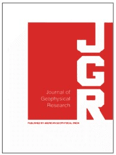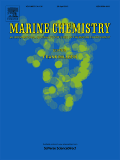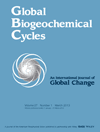
Journal of Geophysical Research-Biogeosciences
Scope & Guideline
Uncovering Insights into Earth's Vital Biogeochemical Processes.
Introduction
Aims and Scopes
- Biogeochemical Cycles:
Research on the cycling of nutrients and elements (like carbon and nitrogen) through different ecosystems, examining how these cycles are influenced by environmental changes. - Ecosystem Responses to Climate Change:
Studies investigating how ecosystems respond to climate variability and extreme weather events, including changes in productivity, composition, and biogeochemical processes. - Aquatic and Terrestrial Interactions:
Exploration of the connections between terrestrial and aquatic ecosystems, including the fluxes of carbon and nutrients between these domains. - Remote Sensing and Modeling:
Utilization of remote sensing technologies and modeling approaches to assess and predict ecosystem dynamics and biogeochemical processes on various scales. - Microbial Ecology:
Investigations into the roles of microbial communities in nutrient cycling, organic matter decomposition, and their responses to environmental stressors. - Land-Use and Management Effects:
Research on how different land-use practices and management strategies impact ecosystem services, carbon storage, and nutrient dynamics.
Trending and Emerging
- Climate Change Adaptation and Resilience:
An increasing focus on understanding how ecosystems adapt to climate change, including resilience mechanisms and strategies for mitigation. - Integration of Remote Sensing with Ground Observations:
The trend towards combining remote sensing data with ground-based observations to enhance the accuracy of ecological assessments and improve modeling efforts. - Microbial Contributions to Biogeochemical Processes:
A growing emphasis on the role of microbial communities in driving biogeochemical cycles, particularly in relation to carbon and nutrient cycling. - Impact of Land Use Change on Ecosystem Functions:
Research exploring the effects of land use changes on ecosystem services, nutrient dynamics, and greenhouse gas emissions is gaining traction. - Emerging Contaminants and Ecosystem Health:
An increasing interest in the effects of emerging contaminants (like pharmaceuticals and microplastics) on ecosystem health and biogeochemical processes. - Machine Learning in Environmental Sciences:
The utilization of machine learning and artificial intelligence techniques to analyze large datasets and improve predictions related to biogeochemical processes and ecosystem dynamics.
Declining or Waning
- Traditional Soil Chemistry Studies:
There seems to be a waning interest in classical soil chemistry studies that do not incorporate biological interactions or broader ecological implications. - Single-Factor Analyses:
Research focusing solely on single environmental factors (e.g., temperature or moisture) without considering the complex interactions in ecosystems is becoming less common. - Historical Ecology Studies:
Investigations that rely heavily on historical data without integrating modern methodologies or ecological modeling are appearing less frequently. - Static Ecosystem Models:
There is a noticeable decline in the use of static models that do not account for dynamic changes in ecosystems, as researchers increasingly prefer more adaptable and responsive modeling approaches. - Studies on Isolated Ecosystems:
Research focused exclusively on isolated ecosystems without considering their connectivity and interactions with surrounding environments is becoming less prevalent.
Similar Journals

MARINE CHEMISTRY
Pioneering Research in Marine Chemical DynamicsMARINE CHEMISTRY, published by Elsevier, is a premier international journal that has been at the forefront of advancing knowledge in the fields of chemistry, oceanography, and environmental science since its inception in 1972. As indicated by its impressive impact factor and its numerous Q1 rankings in Chemistry, Oceanography, and Water Science and Technology for 2023, the journal is a vital resource for researchers and professionals dedicated to addressing critical issues related to marine environments and their chemical dynamics. The journal publishes high-quality research that explores various aspects of chemical processes in aquatic systems, aiming to bridge the gap between theoretical studies and practical applications. With a significant emphasis on interdisciplinary work, MARINE CHEMISTRY serves as a platform for sharing innovative research findings that contribute to the sustainability and health of marine ecosystems. Although it is not an open-access publication, its comprehensive repository of scholarly articles remains accessible through institutional subscriptions, providing limitless opportunities for growth and discovery in the field.

GLOBAL BIOGEOCHEMICAL CYCLES
Leading the charge in interdisciplinary environmental research.GLOBAL BIOGEOCHEMICAL CYCLES, published by the American Geophysical Union, is a leading journal in the field of geochemistry that has gained significant recognition since its inception in 1987. With an impressive impact factor and a Q1 ranking in multiple categories such as Atmospheric Science, Environmental Chemistry, and Global and Planetary Change, it serves as a crucial platform for the dissemination of high-quality research. This journal emphasizes interdisciplinary studies focusing on biogeochemical processes and their implications for global environmental change, attracting contributions from a diverse range of scientific communities. Researchers, professionals, and students engaged in atmospheric sciences, environmental chemistry, and planetary sciences will find invaluable insights and state-of-the-art methodologies within its pages. GLOBAL BIOGEOCHEMICAL CYCLES continues to advance our understanding of the Earth’s systems, thus holding a pivotal position in shaping future environmental policies and sustainability efforts.

BIOGEOCHEMISTRY
Pioneering research at the intersection of environment and science.BIOGEOCHEMISTRY is an esteemed journal published by Springer, dedicated to advancing the understanding of biogeochemical processes across a range of ecosystems. Since its inception in 1984 and continuing into its converged trajectory through 2024, the journal has established itself as a critical resource in the fields of Earth-Surface Processes, Environmental Chemistry, and Water Science and Technology. With a prestigious Q1 ranking across these categories as of 2023, it ranks among the top journals in its field, reflecting its significant impact on current research and knowledge dissemination. Researchers, professionals, and students alike can benefit from the journal's rigorous peer-reviewed articles that contribute vital insights and innovative research findings. Although currently not an open-access journal, BIOGEOCHEMISTRY remains a leading platform for sharing high-quality scientific work that addresses pressing environmental challenges.

Environmental Microbiology Reports
Connecting Microbial Insights to Environmental SustainabilityEnvironmental Microbiology Reports, published by WILEY, is a prestigious journal dedicated to the field of environmental microbiology, exploring the intricate interactions between microorganisms and their environments. With an ISSN of 1758-2229, this journal has established itself as a crucial resource for researchers, professionals, and students interested in the latest advancements and applications in microbial ecology, soil science, and environmental sustainability. Since its inception in 2009, the journal has grown in impact and reputation, proudly ranked in the Q1 category for both Agricultural and Biological Sciences and Ecology, Evolution, Behavior and Systematics as of 2023. Notably, it occupies the 17th position out of 193 in its subcategory based on Scopus rankings, showcasing its significance within the field. Although it does not currently offer open access options, the high-quality research published in this journal continues to contribute significantly to the understanding of microbial roles in environmental processes, emphasizing the vital role of microbes in maintaining ecosystem health and promoting sustainable practices.

ECOLOGICAL RESEARCH
Advancing ecological understanding through rigorous research.ECOLOGICAL RESEARCH is a prestigious academic journal published by WILEY, dedicated to advancing the field of ecology and its associated disciplines. Since its inception in 1986, the journal has consistently provided a platform for high-quality, peer-reviewed research, contributing significantly to the understanding of ecological systems and their complexities. With an impressive 2023 impact factor reflected in its Q1 ranking in the category of Ecology, Evolution, Behavior, and Systematics, it stands among the top journals in its field, as evidenced by its Scopus rank of #192 out of 721 and placement in the 73rd percentile. While accessible through standard subscription models, this journal plays an essential role in disseminating crucial findings and innovative methodologies to researchers, professionals, and students alike. With a commitment to fostering ecological knowledge and collaboration, ECOLOGICAL RESEARCH continues to influence ecological practices and policies, shaping the future of research in this critical area.

Soil Ecology Letters
Elevating Understanding of Soil Functions and ImpactSoil Ecology Letters, published by SpringerNature, is a premier journal dedicated to advancing the knowledge and understanding of soil ecosystems, their functions, and their vital role in global sustainability. Since its inception in 2019, this leading journal has consistently maintained its prestigious Q1 ranking in Ecology, Evolution, Behavior and Systematics, as well as Soil Science, reflecting its significant impact in the ecological and environmental sciences community. With an impressive Scopus ranking that places it within the top percentile of journals in its field, Soil Ecology Letters provides a platform for researchers and professionals to disseminate their groundbreaking findings. The journal is a vital resource for advancing research in agricultural and biological sciences, offering open access options that promote widespread dissemination of knowledge. With its focus on fostering collaboration and innovation in soil ecology, this journal is essential reading for anyone aiming to deepen their understanding of soil environments and their critical role in ecological health.

JOURNAL OF GEOPHYSICAL RESEARCH-OCEANS
Innovating Insights into Oceanic PhenomenaJournal of Geophysical Research-Oceans is a premier interdisciplinary journal published by the American Geophysical Union, focused on the dynamic field of ocean sciences. With a rich history dating back to 1986, this journal has become a pivotal platform for researchers, providing a wealth of data and innovative insights into oceanographic processes and their essential role within the Earth's system. The journal enjoys an impressive impact factor and consistently ranks in the Q1 quartile across numerous categories, including Earth and Planetary Sciences and Oceanography, making it a respected source for cutting-edge research and reviews. Notably, it holds significant positions within Scopus rankings, further emphasizing its importance in shaping the scientific discourse surrounding oceanic phenomena. While available through subscription, the Journal of Geophysical Research-Oceans remains an invaluable resource for academics, industry professionals, and students eager to deepen their understanding of ocean dynamics and geophysical interactions.

Frontiers in Marine Science
Unveiling the Secrets of Oceanic InterconnectednessFrontiers in Marine Science, published by FRONTIERS MEDIA SA, stands as a leading open-access journal dedicated to advancing our understanding of marine ecosystems and their interconnectedness with global environmental systems. With a focus that spans a range of vital sub-disciplines including Aquatic Science, Oceanography, and Ocean Engineering, this journal has achieved prestigious rankings within the Q1 category in multiple areas as of 2023. The journal, thriving since its inception in 2014, promotes high-quality, peer-reviewed research that addresses critical challenges in marine and environmental science, making it an invaluable resource for researchers, professionals, and students alike. Located in Switzerland, Frontiers in Marine Science is committed to accessible scientific knowledge, boasting an impressive impact through a wide array of contributions from the global community. The journal's aim is to foster collaborative research efforts and innovative responses to the pressing issues facing our oceans and waterways today.

Annual Review of Marine Science
Exploring the depths of marine science innovation.The Annual Review of Marine Science is a leading academic journal published by Annual Reviews, dedicated to advancing the field of marine science through comprehensive and insightful reviews. With an ISSN of 1941-1405 and E-ISSN 1941-0611, this esteemed journal has established itself as a critical resource for researchers, professionals, and students alike. Recognized for its exceptional quality, it holds a prestigious Q1 ranking in Oceanography for 2023, ranking first out of 145 journals in the Earth and Planetary Sciences category, placing it within the top 1% of its field. The Annual Review of Marine Science covers an expansive scope, incorporating cutting-edge research that spans the biological, chemical, and physical realms of marine studies. It fosters an environment of knowledge sharing and academic discourse, thereby augmenting the understanding of marine ecosystems and their global significance. While the journal is not open access, it ensures that the latest advancements and reviews are made available to a broad audience, reflecting the importance of marine science in addressing pressing environmental challenges. With its dedicated editorial team and commitment to scholarly rigor, the journal is an indispensable platform for advancing marine research and education from its base in the United States.

AGRICULTURAL AND FOREST METEOROLOGY
Advancing knowledge at the crossroads of climate and agriculture.AGRICULTURAL AND FOREST METEOROLOGY, published by Elsevier, is a premier journal dedicated to the intersection of meteorology, agriculture, and forestry, with a substantial impact on the understanding of climate interactions and their implications on natural resources and food security. Featuring an ISSN of 0168-1923 and an E-ISSN of 1873-2240, this journal has maintained an impressive track record since its establishment in 1984 and is set to continue through 2024. Currently categorized in the Q1 quartile across multiple fields—including Agronomy and Crop Science, Atmospheric Science, Forestry, and Global and Planetary Change—AGRICULTURAL AND FOREST METEOROLOGY is recognized as a leading source in its disciplines, ranked in the 94th percentile for both Agronomy and Atmospheric Science. Researchers and professionals in the field can expect to find high-quality, peer-reviewed articles that contribute significantly to the advancement of knowledge and practice. This journal serves as an essential platform for disseminating critical findings that inform science-based strategies for managing agricultural and forest ecosystems in response to a changing climate.